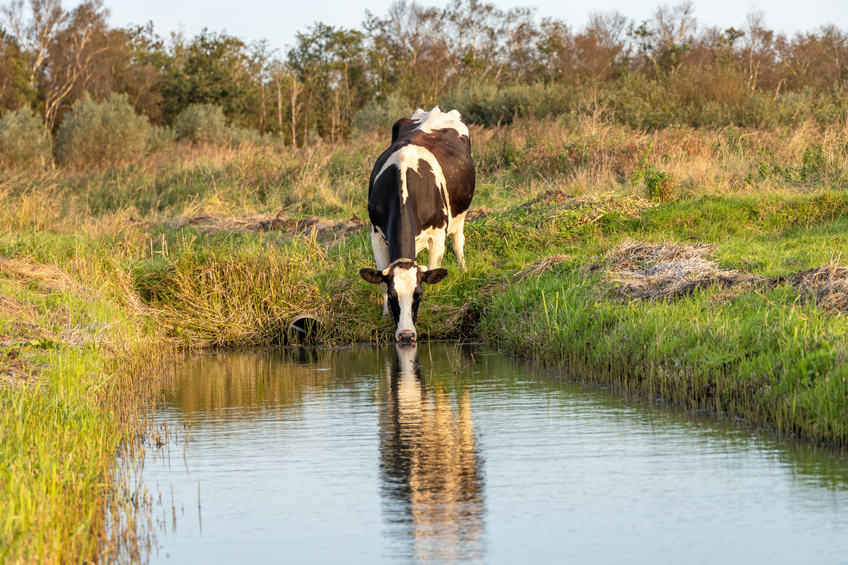
Livestock and Agriculture Water Quality and Drinking Water and the Farmer

An agricultural operation is dependent on not only the health of the livestock, but also the ecosystem of the farm and the area around the agricultural operation, and the farmers health. One very important topic is the quality of the water used for livestock consumption, irrigation, and the water consumed by the farmer. The quality of this water depends on the location of the operation, season of the year, local soils and geology, existing and historic land-use, farming practices, i.e., manure management, improper management, and the source of the water. In many cases, a surface water source may have significant variations in source supply and also source quality and be more vulnerable to contamination; whereas, a groundwater source may be less variable and less vulnerable to anthropogenic impacts.
Livestock / Humans
Livestock, just like humans, are vulnerable to water quality contamination. Microbiological sources of contamination can include Total Coliform, E. coli, algal by-products (HAB), other Bacteria like leptospirosis and fusobacterium, pathogens, and Viruses.
“Leptospirosis is an illness caused by the Bacteria Leptospira. Leptospira can enter the body through cuts and breaks in the skin, through consumption of water contaminated by urine or reproductive fluids, and through other mucous membranes, such as the eyes, mouth, and nose. In humans, Leptospirosis causes flu-like symptoms and in rare cases can cause Weil’s syndrome, which can be fatal. Leptospirosis can be spread between humans and animals and common animal vectors include cattle, pigs, dogs, reptiles, amphibians, and rodents. In farm animals, this disease has been associated with low milk production, infertility, and late-term abortion. Weil's disease is the acute form of Leptospirosis and causes the infected individual to become jaundiced, develop kidney failure, and coughing up blood depending where if the infection is located in the liver, kidney, brain, lungs, or heart.”
Fusobacterium necrophorum is a Bacterial pathogen to both humans and animals. In humans, this pathogen impacts the mucous membranes and in humans it can cause periodontal diseases, Lemierre's syndrome, and topical skin ulcers. “Lemierre’s syndrome occurs when you get infected by Fusobacterium necrophorumin your throat that when not properly treated spreads to lymph system. When these vessels carrying the lymphy system fluid become infected, they can’t properly return fluids that have leaked from bloodstream back into your circulatory system causing vessels to swell.” This infection spreads to the vessels in the neck where blood clots can form in the jugular vein or dislodge from the jugular and travel to the lungs where the infection can spread to the skeletal system, spleen, liver, kidney, heart, or brain.
In animals, the infection by Fusobacterium necrophorum and Dichelobacter nodusus is commonly known as “foot-rot.” Foot-rot is a contagious disease of cloven-hoofed mammals that causes inflammation of the foot and subsequent lameness.” Dichelobacter nodusus bacterial source is typically the associated with the feet of other infected animals; whereas, Fusobacterium necrophorum is more typically associated with manure and contaminated soil.
Table 1 is a listing of the recommended animal drinking water quality limits for microbiological agents, salts, and metals.
Table 2 is the guidelines related to the total dissolved solids content of the water used for livestock consumption.
Table 3 is recommended limits for some specific organic contaminants in irrigation water.
Table 1 | Recommended Limits for Animal/ Livestock Drinking Water
Table 2 | Guidelines Related to the Total Dissolved Solids Content of the Water Used for Livestock Consumption
Table 3 | Herbicides in Irrigation Water Limits
Testing Recommendations
1. Each potential source should have a comprehensive water test completed before using and you should order a Neighborhood Environmental Hazard Report.
2. If necessary, the appropriate water treatment system should be installed or improvements to surface water sources made to protect the source.
3. The raw water quality should be tested seasonally or at least annually and perhaps there should be regular (seasonal or annual) testing of the “treated” water quality.
Monitoring Tools
Hanna Instruments HI 9813-6N Waterproof pH/EC/TDS Temperature Meter Clean and Calibration Check
Testing Tools
Agricultural Testing - Hydroponics Testing
Spring and Water Well / Groundwater Testing
Organic Farmers – We recommend testing for “Forever Chemicals”
References:
Australian Water Quality Guidelines for Fresh and Marine Waters, National Water Quality Management Strategy, ANZECC, 1992. (View PDF)
Agriculture Waste Management Field Handbook, Laws, Regulations, Policy, and Water Quality Criteria, Part 651, Chapter 1, Part 651, June 2009. (View PDF)
Beedem D.K., Evaluation of Water Quality and Nutrition for Dairy Cattle, 2019 (View PDF)
Schroeder, J.W., Water Needs for Quality Guidelines for Dairy Cattle, 2015. (View PDF)

